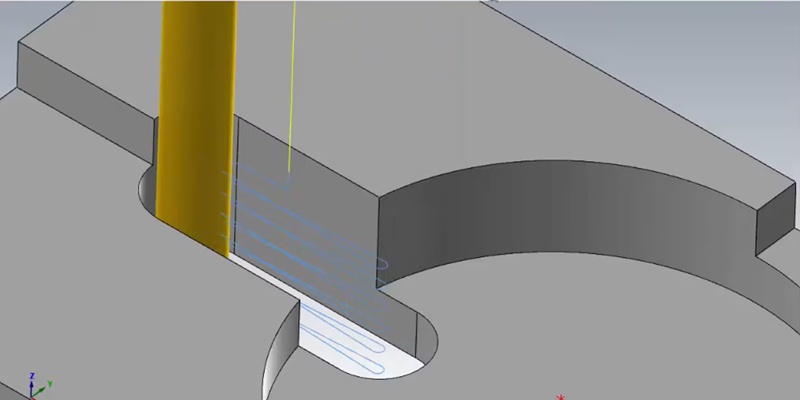Slot milling is a machining operation performed using CNC lathes or machining centers, utilizing rotating cutting tools to create narrow, elongated openings or channels in a workpiece. These slots play a crucial role in assembly alignment, fastening, stress distribution, weight reduction, and more. CNC milling is widely used for slot creation in materials like metal, plastic, and composites. This article outlines the basics of slot milling, different techniques, and the appropriate tooling.

What is Slot Milling?
Slot milling is a machining process where a rotating cylindrical cutter removes material to form narrow grooves (slots) in a workpiece. This process is commonly performed on CNC machines and allows for precise cutting with controlled depth and width. Slot milling is often used in industries like automotive, aerospace, and mold-making, where grooves, keyways, and channels are integral parts of the product. The cutter’s feed rate, speed, and position can be adjusted for different slot depths and widths. Complex slots may require more advanced CNC programming and tool path optimization, often done using CAM software.
- Conventional Tool Path: A straightforward method for cutting slots, though it may cause more vibration.
- Trochoidal Tool Path: Provides better stability and allows for cutting hard-to-machine materials.
- Plunging Tool Path: Creates axial cuts similar to drilling using slot milling cutters.
Slot Milling Techniques and Tooling
Slot milling can be accomplished through various techniques, each with its own tools and capabilities.
Techniques Overview:
- End Milling: Uses end mills or shell mills to create slots of different depths and sizes.
- Side Milling: Cuts linear grooves using a slot milling cutter attached to a horizontal machine.
- Gang Milling: Cuts multiple parallel slots at once using multiple tools mounted on a single arbor.
- T-Slot Cutting: Forms “T-shaped” grooves in a workpiece using T-slot cutters.
- Woodruff Key Slot Cutting: Cuts half-circle key slots for interlocking mechanisms using Woodruff key cutters.
Summary Table: Slot Milling Techniques and Corresponding Tools
| Technique | Slot Milling Tools |
|---|---|
| End Milling | End mills, shell mills |
| Side Milling | Slot milling cutters, side-and-face cutters |
| Gang Milling | Multiple slot cutters on one arbor |
| T-Slot Cutting | T-slot cutters |
| Woodruff Key Slot Cutting | Woodruff key cutters |
Tips for Successful Slot Milling
- Smooth Tool Entry: Reduce the cutting speed when the tool makes initial contact to avoid vibration and misalignment.
- Chip Evacuation: Perform slot cutting in multiple passes to ensure efficient chip removal, which prevents tool wear and overheating.
- Optimal Feed Rate and Force: Use the correct feed rate and cutting force to avoid excessive tool wear or slow cutting speeds.
- Use Down Milling: Wherever possible, use the down milling method for better stability and improved chip evacuation.
Uses of Slot Milling
Slot milling serves various important functions in mechanical components:
- Keyways: Slots for torque transmission in shafts.
- Grooves: Channels in injection molds or sand-casting dies.
- Ventilation Slots: Openings for airflow in enclosures.
- T-Slots: For machine bases and workbenches.
- Gear Teeth Slots: Space for gear teeth or clearance.
- Assembly Interlocks: Slots for aligning and fastening parts.
- Fluid Flow Channels: Slots for hydraulic systems.
Conclusion
Slot milling offers various techniques, each suited to different slot profiles, sizes, and applications. From keyways to ventilation slots, this versatile process is widely used in many industries. For complex parts and assembly features, slot milling is an essential operation. At LongSheng, we provide advanced CNC milling services for custom slot milling projects. Contact us today for an instant quote!
Disclaimer
The content appearing on this webpage is for informational purposes only. LongSheng makes no representation or warranty of any kind, be it expressed or implied, as to the accuracy, completeness, or validity of the information. Any performance parameters, geometric tolerances, specific design features, quality and types of materials, or processes should not be inferred to represent what will be delivered by third-party suppliers or manufacturers through LongSheng’s network. Buyers seeking quotes for parts are responsible for defining the specific requirements for those parts. Please contact to our for more information.
Team LongSheng
This article was written by various LongSheng contributors. LongSheng is a leading resource on manufacturing with CNC machining, sheet metal fabrication, 3D printing, injection molding,metal stamping and more.

